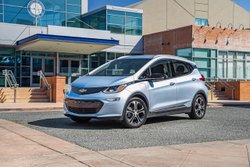Turning Cars as a Service into an Auto Business
General Motors has rebounded nicely from its brush with bankruptcy less than a decade ago, but new challenges outside the traditional automotive industry are putting new stresses on GM and the rest of the automakers. The challenge is to the fundamentals of the car business. Where it used to be good enough to create a popular model and market it successfully, the basics appear to be shifting. The younger generation doesn’t seem to have the same attachment to cars as its parents. Driver’s licenses are being obtained at later dates. Car purchases are delayed as car sharing programs and ride-hailing services fill the gap for short trips and air travel and discounted bus services take the place of what used to longer car trips. It may not be a groundswell, but a shift has definitely been registered as companies like Lyft go from giving one million trips a year to one million a week in a few years’ time.

Every car company that expects to continue to be around is crafting a response to these changes, but GM appears to be forging new ground. It has launched a subsidiary (it’s first since Saturn) called Maven, which has the three-pronged mission of creating a car-sharing service (for cities, residential communities or commercial entities) while also developing what it calls a “mobility platform” (Maven Gig) that provides short-term car rentals to individuals engaged in the new gig economy.
The Maven on-demand car sharing service operates in 17 cities. Maven Gig is launched in three West Coast cities with more coming later this year.
Interview with the Chief Growth Officer
Rachel Bhattacharya, chief growth officer for Maven, in a recent interview with Clean Fleet Report, said her portion of the company (Maven Gig) is a business-to-business operation that includes:
- Lyft Express Drive,
- an Uber partnership and
- future business cases.
She characterizes her business unit as “a start-up inside a major corporation.” She adds that Maven in integrated to GM where it needs to be, but not anywhere “where it slows down our business.”

Unlike short-term Silicon Valley investors, GM is looking at a 10-year investment horizon, giving Maven time and room to grow and find its way to provide a new revenue stream for the corporation. “There’s no substitute for real world experience,” Bhattacharya added.
Maven is “distinct from the core (GM) business,” Bhattacharya said, “very, very different.” That helps explain how a self-proclaimed non car person (“I am a mobility person,” she clarified) with experience at Starbucks and Bain & Co could end up here.
The trends are clear. Estimates quoted by Maven have 43 percent of the U.S. workforce as freelance workers by 2020. While the car-sharing side of Maven may provide a car for an hour to go to a meeting for those freelancers, Maven Gig aims to rent cars (five models initially with inclusive packages that include insurance and maintenance and, in the case of the Bolt, free fast-charging) to those gigging for GrubHub, Instacart, Roadie or ridesharing services like Lyft and Uber (or, more likely, those engaging in multiple services).
Bolt EV Gets Big Push
The big push at Maven Gig has been with the new Bolt EV. With a 238-mile range and free charging, unlimited miles, maintenance and insurance thrown into the mix for $229 a week, the new business is getting regular takers. The Maven Gig program started with 150 Bolts in San Diego and just launched in San Francisco and Los Angeles and expands to other urban areas soon.
Maybe hitting on one of the other hallmarks of the new economy, Maven Gig emphasizes flexibility and the lack of commitment and the ability to try out something with its weekly rentals. By letting drivers have that flexibility, GM gets several things in return:
- Revenue from the weekly rentals
- Exposure of the vehicles to new potential customers (both the renters and riders)
- Rapid real-world feedback on vehicle performance (particularly critical for a new model like the Bolt and may play a significant role in future models)
- Avenue to increase revenue on vehicles coming back from leases or daily rental use

Bhattacharya said that while she sees a desire in cities to be “autonomous ready,” she doesn’t see it as a big Maven push. “Our (current) customers are drivers,” she noted. As autonomous cars become part of the mix, she looks to integrate with mass transit, using Maven as a learning experience with autonomous in the same way its’ been with electric cars (Bolt).
This software-based business is on a 12-18-month update cycle compared to the two and four-year (or more of the traditional auto industry, but it also syncs up with the traditional industry. Maven drivers and cars provide a quick feedback loop to GM product development, something not seen in traditional daily car rental services.
Maven also is driving infrastructure development. It has a partnership with EVgo for fast-charging and is giving input into where to expand infrastructure based on Gig users.
As for future expansion—Bhattacharya said Maven is city-oriented, but looking to pursue a partnership model with universities and employers, working on a case-by-case basis to deliver “what kind of solution is needed, finding where is there value for Maven to add.” The Maven business case is based on volume, Bhattacharya said (much like the larger auto industry), “but it’s easy to meet.”
Related Stories You Might Enjoy:
Peersonal: My Chevrolet Bolt–a Six-Month Check-in

4 thoughts on “GM’s Maven Moves into the Gig Economy with Bolt EVs”